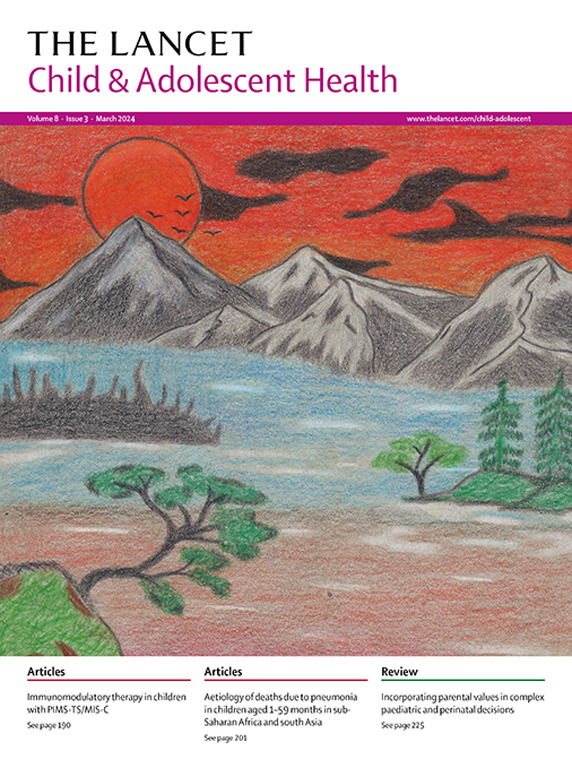Asthma symptoms, severity, and control with and without a clinical diagnosis of asthma in early adolescence in sub-Saharan Africa: a multi-country, school-based, cross-sectional study
IF 19.9
1区 医学
Q1 PEDIATRICS
引用次数: 0
Abstract
Background
Rapid urbanisation and population growth in sub-Saharan Africa has increased the incidence of asthma in children and adolescents. One major barrier to achieving good asthma control in these adolescents is obtaining a clinical diagnosis. To date, there are scant data on prevalence and severity of asthma in undiagnosed yet symptomatic adolescents. We therefore aimed to assess symptom prevalence and severity, the effect of symptoms on daily life, and objective evidence of asthma in young adolescents from sub-Saharan Africa with and without a clinical diagnosis of asthma by spirometry and fractional exhaled nitric oxide (FeNO).
Methods
We designed a two-phase, multi-country, school-based, cross-sectional study to assess symptom prevalence and severity in sub-Saharan African adolescents. In phase 1 we surveyed young adolescents aged 12–14 years who were attending selected primary and secondary schools in Blantyre in Malawi, Durban in South Africa, Harare in Zimbabwe, Kampala in Uganda, Kumasi in Ghana, and Lagos in Nigeria. The adolescents were screened for asthma symptoms using the International Study of Asthma and Allergies in Children (ISAAC) questionnaire. Then, after opt-in consent, symptomatic adolescents were invited to complete a detailed survey on asthma severity, treatment, and exposure to environmental risk factors for phase 2. Adolescents performed the European Respiratory Society's diagnostic tests for childhood asthma. A positive asthma test was classified as a forced expiratory volume in 1 sec (FEV1) predicted under 80%, a FEV1 under the lower limits of normal, or FEV1 divided by forced vital capacity (FEV1/FVC) under the lower limits of normal; positive bronchodilator responsiveness or reversibility was defined as either an increase in absolute FEV1 of 12% or more, or an increase of 200 mL or more, or both, after 400 μg of salbutamol (shortacting β2 agonist) administered via a metered-dose inhaler and spacer, or FeNO of 25 parts per billion or higher, or any combination of these. The study was registered with ClinicalTrials.gov (NCT03990402) and is complete.
Findings
Between Nov 1, 2018, and Nov 1, 2021, we recruited 149 schools from six regions in six sub-Saharan countries to participate in the study. We administered phase 1 asthma questionnaires from Jan 20, 2019 to Nov 11, 2021, and from 27 407 adolescents who were screened, we obtained data for 27 272 (99·5%). Overall, 14 918 (54·7%) adolescents were female and 12 354 (45·3%) adolescents were male, and the mean age was 13 years (IQR 12–13); nearly all recruited adolescents were of black African ethnicity (26 821 [98·3%] of 27 272). In phase 1, a total of 3236 (11·9% [95% CI 11·5–12·3]) reported wheeze in the past 12 months, and 644 (19·9%) of 3236 had a formal clinical diagnosis of asthma. The prevalence of adolescents with asthma symptoms ranged from 23·8% in Durban, South Africa to 4·2% Blantyre, Malawi. Using ISAAC criteria, severe asthma symptoms were reported by 2146 (66·3%) of 3236 adolescents, the majority of whom (1672 [77·9%] of 2146) had no diagnosis of asthma by a clinician. Between July 16, 2019, and Nov 26, 2021, we administered the phase 2 questionnaire to the 1654 adolescents who had asthma symptoms in phase 1 and consented to proceed to the second phase. In the phase 2 cohort, 959 (58·0%) were female and 695 (42·0%) were male, and the mean age was 13 years (IQR 12–14). One or more diagnostic tests for asthma were obtained in 1546 (93·5%) of 1654 participants. One or more positive asthma tests were found in 374 (48·8%) of 767 undiagnosed adolescents with severe symptoms, and 176 (42·4%) of 415 of undiagnosed adolescents with mild-to-moderate symptoms. Of the 392 adolescents in phase 2 with clinician-diagnosed asthma, 294 (75·0%) reported severe asthma symptoms, with 94 (32·0%) of those with severe symptoms not using any asthma medication. In general, findings in both phases 1 and 2 were consistent across sub-Saharan African countries.
Interpretation
A large proportion of adolescents in sub-Saharan Africa with symptoms of severe asthma do not have a formal diagnosis of asthma and are therefore not receiving appropriate asthma therapy. To improve the poor state of asthma control in sub-Saharan Africa, potential solutions such as educational programmes, better diagnosis, and treatment and screening in schools should be considered.
Funding
UK National Institute for Health and Care Research and UK Medical Research Council.
撒哈拉以南非洲青少年早期哮喘症状、严重程度和控制情况:一项基于学校的多国横断面研究。
背景:撒哈拉以南非洲地区的快速城市化和人口增长增加了儿童和青少年的哮喘发病率。在这些青少年中实现良好的哮喘控制的一个主要障碍是获得临床诊断。迄今为止,有关未确诊但有症状的青少年哮喘发病率和严重程度的数据还很少。因此,我们旨在通过肺活量测定和一氧化氮呼气分数(FeNO)来评估撒哈拉以南非洲地区临床诊断为哮喘和未诊断为哮喘的青少年的症状发生率和严重程度、症状对日常生活的影响以及哮喘的客观证据:我们设计了一项分两个阶段、基于学校的多国横断面研究,以评估撒哈拉以南非洲青少年的症状发生率和严重程度。在第一阶段,我们对马拉维布兰太尔、南非德班、津巴布韦哈拉雷、乌干达坎帕拉、加纳库马西和尼日利亚拉各斯的部分中小学中 12-14 岁的青少年进行了调查。研究人员使用国际儿童哮喘和过敏症研究(ISAAC)问卷对这些青少年进行了哮喘症状筛查。然后,在征得同意后,邀请有症状的青少年完成关于哮喘严重程度、治疗和环境危险因素暴露的详细调查,以进行第二阶段的研究。青少年进行欧洲呼吸协会的儿童哮喘诊断测试。哮喘测试阳性的分类是:1 秒用力呼气容积(FEV1)预测值低于 80%,FEV1 低于正常值下限,或 FEV1 除以用力呼吸量(FEV1/FVC)低于正常值下限;支气管扩张剂阳性反应性或可逆性的定义是:通过计量吸入器和喷雾器吸入 400 微克沙丁胺醇(短效 β2 激动剂)后,FEV1 绝对值增加 12% 或以上,或增加 200 毫升或以上,或两者均增加。该研究已在ClinicalTrials.gov(NCT03990402)注册,研究结果已完成:2018年11月1日至2021年11月1日期间,我们招募了来自撒哈拉以南6个国家6个地区的149所学校参与研究。我们在 2019 年 1 月 20 日至 2021 年 11 月 11 日期间发放了第 1 阶段哮喘调查问卷,并从 27 407 名接受筛查的青少年中获得了 27 272 人(99-5%)的数据。总体而言,14 918 名(54-7%)青少年为女性,12 354 名(45-3%)青少年为男性,平均年龄为 13 岁(IQR 12-13);几乎所有被招募的青少年都是非洲黑人(27 272 人中有 26 821 人[98-3%])。在第一阶段,共有 3236 人(11-9% [95% CI 11-5-12-3])报告在过去 12 个月中出现过喘息,3236 人中有 644 人(19-9%)被正式临床诊断为哮喘。有哮喘症状的青少年发病率从南非德班的 23-8% 到马拉维布兰太尔的 4-2% 不等。根据 ISAAC 标准,3236 名青少年中有 2146 人(66-3%)报告了严重的哮喘症状,其中大多数人(2146 人中有 1672 人[77-9%])未经临床医生诊断患有哮喘。2019 年 7 月 16 日至 2021 年 11 月 26 日期间,我们对在第一阶段出现哮喘症状并同意进入第二阶段的 1654 名青少年进行了第二阶段问卷调查。在第二阶段的队列中,959(58-0%)人为女性,695(42-0%)人为男性,平均年龄为 13 岁(IQR 12-14)。在 1654 名参与者中,有 1546 人(93-5%)接受了一次或多次哮喘诊断测试。在 767 名症状严重的未确诊青少年中,有 374 人(占 48-8%)在一次或多次哮喘检测中呈阳性;在 415 名症状轻微至中度的未确诊青少年中,有 176 人(占 42-4%)在一次或多次哮喘检测中呈阳性。在第二阶段的 392 名经临床医生诊断患有哮喘的青少年中,有 294 人(75-0%)报告有严重的哮喘症状,其中有 94 人(32-0%)的严重症状患者没有使用任何哮喘药物。总的来说,撒哈拉以南非洲国家在第一和第二阶段的调查结果是一致的:在撒哈拉以南非洲地区,大部分有严重哮喘症状的青少年没有得到哮喘的正式诊断,因此没有接受适当的哮喘治疗。为改善撒哈拉以南非洲地区哮喘控制不佳的状况,应考虑在学校开展教育计划、改善诊断、治疗和筛查等潜在解决方案:资金来源:英国国家健康与护理研究所和英国医学研究委员会。
本文章由计算机程序翻译,如有差异,请以英文原文为准。
求助全文
约1分钟内获得全文
求助全文
来源期刊

Lancet Child & Adolescent Health
Psychology-Developmental and Educational Psychology
CiteScore
40.90
自引率
0.80%
发文量
381
期刊介绍:
The Lancet Child & Adolescent Health, an independent journal with a global perspective and strong clinical focus, presents influential original research, authoritative reviews, and insightful opinion pieces to promote the health of children from fetal development through young adulthood.
This journal invite submissions that will directly impact clinical practice or child health across the disciplines of general paediatrics, adolescent medicine, or child development, and across all paediatric subspecialties including (but not limited to) allergy and immunology, cardiology, critical care, endocrinology, fetal and neonatal medicine, gastroenterology, haematology, hepatology and nutrition, infectious diseases, neurology, oncology, psychiatry, respiratory medicine, and surgery.
Content includes articles, reviews, viewpoints, clinical pictures, comments, and correspondence, along with series and commissions aimed at driving positive change in clinical practice and health policy in child and adolescent health.
 求助内容:
求助内容: 应助结果提醒方式:
应助结果提醒方式:


